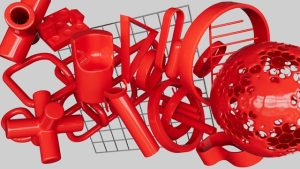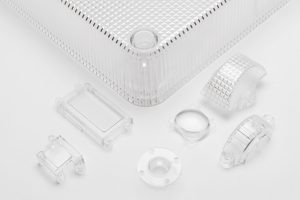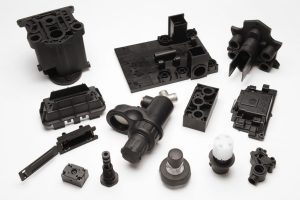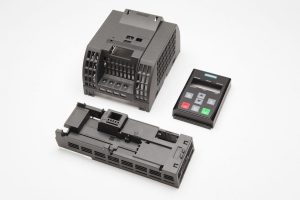In the manufacturing world, plastics are central to most of the products we use every day. From food packaging to medical equipment, the durability, versatility and cost-effectiveness of plastic materials make them indispensable, especially in the injection moulding industry. But what plastic is used in injection moulding?
With almost 400 million metric tons of plastic produced in 2021 alone, the demand for plastic molded products is set to continue to rise. This means whether you’re an experienced manufacturer or new to plastic production, choosing the right types of plastic material for injection molding is crucial. In this article, we’ll explore some of the most common plastics used in injection moulding, as well as their benefits and applications.

What Plastics Are Used In Injection Moulding?
Below are some of the most popular plastics Fern Plastic uses in injection moulding, along with their properties and typical applications.
- Acrylonitrile Butadiene Styrene (ABS)
- Polycarbonate (PC)
- Polyamide (Nylon)
- PC/ABS (Polycarbonate/Acrylonitrile Butadiene Styrene Blend)
- High-Density Polyethylene (HDPE)
- Low-Density Polyethylene (LDPE)
- Polybutylene Terephthalate (PBT)
- Polyoxymethylene (POM/Acetal)
Acrylonitrile Butadiene Styrene (ABS)
Acrylonitrile Butadiene Styrene, commonly known as ABS, is a highly versatile thermoplastic polymer and possibly the most common plastic used in injection moulding. Thanks to its excellent balance of toughness, rigidity, and impact resistance, ABS is a go-to material for products that require durability and a high-quality surface finish. Acrylonitrile Butadiene Styrene is also popular because it is easy to process, which makes it a favourite among manufacturers for creating complex shapes and detailed components.

Why use ABS?
ABS is particularly valued for its toughness and ability to withstand a wide range of temperatures. It also has good aesthetic properties, as it can be easily coloured and finished to a high gloss, making it ideal for consumer products that need to look appealing while also being durable
Polycarbonate (PC)
Polycarbonate, or PC, is a high-performance thermoplastic, popular for its exceptional strength, clarity, and resistance to heat and impact. Unlike other plastics, polycarbonate retains its toughness across a wide range of temperatures, making it ideal for demanding applications where durability is crucial. It is often used as a glass substitute in various products thanks to its transparency and shatter resistance.

Why Use Polycarbonate?
Polycarbonate is an excellent choice for products that require transparency and high-impact resistance. Its ability to withstand extreme conditions without cracking or breaking makes it ideal for safety and optical applications.
Polyamide (PA) – Nylon
Polyamide, commonly referred to as Nylon, is a family of synthetic polymers known for their excellent mechanical properties, particularly in applications requiring high strength, flexibility, and wear resistance. Nylon’s durability and resistance to abrasion make it a popular choice in both engineering and consumer applications. It is available in various grades, including reinforced types that enhance its performance under extreme conditions.

Why Use Polyamide?
Nylon is often used in applications where parts are subjected to high mechanical stress, for example, in automotive or industrial machinery. Its combination of strength, durability, and resistance to wear makes it a reliable material for engineering applications.
PC/ABS (Polycarbonate/Acrylonitrile Butadiene Styrene Blend)
PC/ABS is a blend of Polycarbonate and Acrylonitrile Butadiene Styrene that combines the best properties of both materials. The result has the toughness and heat resistance of PC with the flexibility and ease of processing of ABS. This hybrid material offers enhanced impact strength, making it ideal for applications that require both durability and a high-quality surface finish. Additionally, PC ABS blends are known for their excellent low-temperature performance, making them suitable for environments with fluctuating or extreme temperatures.

Why Use PC ABS?
This blend offers a balanced combination of the toughness and heat resistance of polycarbonate with the impact resistance of ABS. It is widely used in automotive and electronic applications where durability and aesthetic appeal are essential.
High Density Polyethylene HDPE
HDPE or high-density polyethylene is a thermoplastic polymer and one of the most popular and widely used plastics in the world. Also known as polythene, HDPE is made from petroleum and ethylene and can be used to make recyclable products like milk bottles, pipes and bin bags. This makes it ideal for those looking for sustainable options for plastic moulded parts.
Why Use HDPE?
Its exceptional strength and durability, make HDPE ideal for products that need to withstand tough conditions. Its resistance to chemicals and moisture makes it perfect for durable products from outdoor furniture to piping. HDPE’s recyclability also makes it a go-to choice for sustainable applications.
Low Density Polyethylene LDPE
LDPE or low-density polyethylene is a versatile thermoplastic with properties like low temperature flexibility and high strength. These contrasting features make LDPE an excellent choice for applications where good stress resistance and toughness is required. Low density polyethylene has the same chemical formula as HDPE but its low density makes it more lightweight with high ductility. This makes it suitable for a wide range of products from food packaging to medical devices.
Why Use LDPE?
LDPE’s flexibility and impact resistance makes it a great choice for products that require both toughness and pliability. It’s commonly used in toys and medical prosthetics and offers low water absorption and cost-efficiency. Its ability to withstand low temperatures without becoming brittle is another advantage.
Polybutylene Terephthalate PBT
PBT or polybutylene terephthalate is a versatile thermoplastic polyester resin with a semi-crystalline structure. From automotive parts to medical devices, the versatility of PBT is due in part to its wide range of grades which include flame-retardant and reinforced varieties. Polyester resins like PBT have good flow properties making them excellent engineering polymers for injection moulding.
Why Use PBT?
Polybutylene Terephthalate is perfect for industries requiring heat resistance, mechanical strength, and durability. Its excellent electrical insulation properties make it a top choice for automotive parts, electrical components, and appliances. PBT’s UV resistance and colour stability make it a popular choice for outdoor applications.
POM Acetal -Polyoxymethylene
Also known as acetal, polyoxymethylene or POM is a semi-crystalline thermoplastic with high mechanical strength and rigidity. Naturally opaque or white in colour, POM is available in grades that can be glass-reinforced, toughened and UV-stabilised for a range of demanding applications. Polyoxymethylene is ideal for manufacturing complex, precision parts and its scratch-proof nature makes it ideal for creating high-gloss exposed parts.
Why Use Polyoxymethylene?
POM or acetal is highly regarded for its mechanical strength, rigidity, and low friction, making it ideal for precision parts like gears, fasteners, and bearings. Its dimensional stability and wear resistance are perfect for demanding, high-stress environments such as the automotive and consumer goods industries.
Quality Plastics for Injection Moulding
Choosing the right types of plastic for injection molding is crucial for ensuring that your products meet the required performance, aesthetics and budget. Whether you’re producing automotive components, consumer goods, or medical devices, understanding the properties of these common plastics will help you make informed decisions for your next injection moulding project.
If you need guidance in selecting the right material for your application or you’re looking to optimise your production process, our team at Fern Plastics is here to help. We use all of the materials in this guide in our thermoplastic injection moulding. This helps us to provide our customers with a wide range of options for their plastic moulded products. Our experiences allow us to have a good understanding of which plastic material is best suited to your project. Contact us today to learn more about our injection moulding services and how we can support your manufacturing needs.

